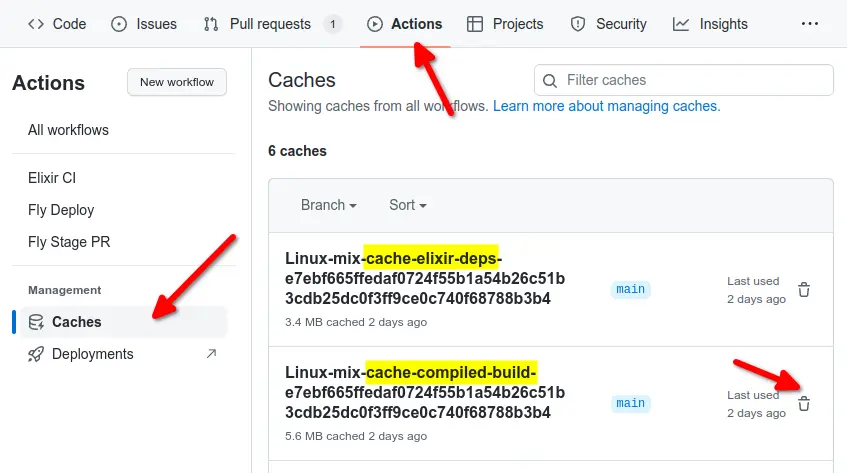
This is about setting up Github Actions to run CI checks for your Elixir and Phoenix projects on Github. Fly.io is a great place to run those Elixir applications! Check out how to get started!
A critical ingredient for modern development teams is a regularly run set of code checks. If it’s up to every developer to run code tests and checks locally before pushing code, you know it will be forgotten at some point. This leaves it as a problem for someone else to cleanup later. Uncool!
We want the benefits of modern Continuous Integration (CI) workflows for our Elixir projects. This lays out a good starting point that teams can customize to suit their needs.
What is Continuous Integration (CI)?
Continuous integration is a software development practice where developers frequently merge code changes into a central repository. Automated builds and tests are run to assert the new code’s correctness before integrating the changes into the main development branch.
The goal with CI is to find and correct bugs faster, improve software quality and enable software releases to happen faster.
CI is a critical ingredient for modern development teams.
Getting Started
To get started with Github Actions in your project, let’s create a “test” workflow. To do this, create this path and file in the root of your project:
.github/workflows/elixir.yaml
Let’s look at a sample file. Comments are included to explain and document what we’re doing and why.
This information has been added to the Elixir documentation guides for easy reference.
name: Elixir CI
# Define workflow that runs when changes are pushed to the
# `main` branch or pushed to a PR branch that targets the `main`
# branch. Change the branch name if your project uses a
# different name for the main branch like "master" or "production".
on:
push:
branches: [ "main" ] # adapt branch for project
pull_request:
branches: [ "main" ] # adapt branch for project
# Sets the ENV `MIX_ENV` to `test` for running tests
env:
MIX_ENV: test
permissions:
contents: read
jobs:
test:
# Set up a Postgres DB service. By default, Phoenix applications
# use Postgres. This creates a database for running tests.
# Additional services can be defined here if required.
services:
db:
image: postgres:12
ports: ['5432:5432']
env:
POSTGRES_PASSWORD: postgres
options: >-
--health-cmd pg_isready
--health-interval 10s
--health-timeout 5s
--health-retries 5
runs-on: ubuntu-latest
name: Test on OTP ${{matrix.otp}} / Elixir ${{matrix.elixir}}
strategy:
# Specify the OTP and Elixir versions to use when building
# and running the workflow steps.
matrix:
otp: ['25.0.4'] # Define the OTP version [required]
elixir: ['1.14.1'] # Define the elixir version [required]
steps:
# Step: Setup Elixir + Erlang image as the base.
- name: Set up Elixir
uses: erlef/setup-beam@v1
with:
otp-version: ${{matrix.otp}}
elixir-version: ${{matrix.elixir}}
# Step: Check out the code.
- name: Checkout code
uses: actions/checkout@v3
# Step: Define how to cache deps. Restores existing cache if present.
- name: Cache deps
id: cache-deps
uses: actions/cache@v3
env:
cache-name: cache-elixir-deps
with:
path: deps
key: ${{ runner.os }}-mix-${{ env.cache-name }}-${{ hashFiles('**/mix.lock') }}
restore-keys: |
${{ runner.os }}-mix-${{ env.cache-name }}-
# Step: Define how to cache the `_build` directory. After the first run,
# this speeds up tests runs a lot. This includes not re-compiling our
# project's downloaded deps every run.
- name: Cache compiled build
id: cache-build
uses: actions/cache@v3
env:
cache-name: cache-compiled-build
with:
path: _build
key: ${{ runner.os }}-mix-${{ env.cache-name }}-${{ hashFiles('**/mix.lock') }}
restore-keys: |
${{ runner.os }}-mix-${{ env.cache-name }}-
${{ runner.os }}-mix-
# Step: Download project dependencies. If unchanged, uses
# the cached version.
- name: Install dependencies
run: mix deps.get
# Step: Compile the project treating any warnings as errors.
# Customize this step if a different behavior is desired.
- name: Compiles without warnings
run: mix compile --warnings-as-errors
# Step: Check that the checked in code has already been formatted.
# This step fails if something was found unformatted.
# Customize this step as desired.
- name: Check Formatting
run: mix format --check-formatted
# Step: Execute the tests.
- name: Run tests
run: mix test
When the Workflow Runs…
When code is pushed to the main branch, this workflow is run. This happens
either from directly pushing to the main branch or after merging a PR into the
main branch.
This workflow is also configured to run checks on PR branches that target the
main branch. This is where it’s most helpful. We can work on a fix or a new
feature in a branch and as we work and push our code up, it automatically runs
the full gamut of checks we want.
When all steps in the workflow succeed, the workflow “passes” and the automated checks say it can be merged. When a step fails, the workflow halts at that point and “fails”, potentially blocking a merge.
Customizing the Workflow Steps
This workflow is a starting point for a team. Every project is unique and every team values different things. Is this missing something your team wants? Check out some additional steps that can be added to your workflow.
- Add a step to run Credo checks.
- Add a step to run Sobelow for security focused static analysis.
- Add a step to run dialyxir. This runs Dialyzer static code analysis on the project. Refer to the project for tips on caching the PLT.
- Customize the
mix testcommand to include code coverage checks. - Add Node setup and caching if
npmassets are part of the project’s test suite. - Add a step to run mix_audit. This provides
a
mix deps.audittask to scan a project’s Mix dependencies for known Elixir security vulnerabilities - Add a step to run
mix hex.audit. This shows all Hex dependencies that have been marked as retired, which the package maintainers no longer recommended using. - Add a set to run
mix deps.unlock --check-unused. This checks that themix.lockfile has no unused dependencies. This is useful if you want to reject contributions with extra dependencies.
Benefits of Caching
It’s worth spending time tweaking your caches. Why? A lot of effort has been put into speeding up Elixir build times. If we don’t cache the build artifacts, then we don’t reap any of those benefits!
Of course, faster build times means you spend less money running your CI workflow. But that’s not the reason to do it! Better caches mean the checks are performed faster and that means faster feedback. Faster feedback means that, as a team, you save time and can move faster. No waiting 20 minutes for the checks to complete so a PR can be merged. (Yes, I have felt that pain!)
This starting template builds in two caching steps. If node_modules factor
into your project’s tests, then caching there makes a lot of sense too.
Just keep in mind that the reason we cache is to reduce drag on the speed of our team.
If our caches ever cause a problem, and sometimes they can, it’s good to know how to clear them. In our project, go to Actions > (Sidebar) Management > Caches. This is the list of caches saved for the project. We can use our naming format to identify which cache file is for what.

What about Continuous Delivery (CD)?
With CI working, the next obvious question is, “Can I auto-deploy my application on Fly.io?” The answer is an emphatic, “Yes!”
It’s actually pretty straightforward and there’s nothing specific to Elixir about it. The process is documented well in the Continuous Deployment with Fly and GitHub Actions guide.
Discussion
In very short order we’ve got a slick Continuous Integration (CI) workflow running for our Elixir project! Similar approaches can be used for projects hosted on Gitlab and elsewhere.
The goal is to keep the code quality of our application high without slowing down or overly burdening the development process. With a customized CI workflow based on something like this, we get the benefits of Elixir’s improved compile times while enforcing security checks, coding practices and more.
Hopefully this improves your code checks while reducing the friction for your team at the same time!
NOTE: This guide can also be found in the growing section of Elixir documentation.
Fly.io ❤️ Elixir
Fly.io is a great way to run your Phoenix LiveView app close to your users. It’s really easy to get started. You can be running in minutes.
Deploy a Phoenix app today! →
